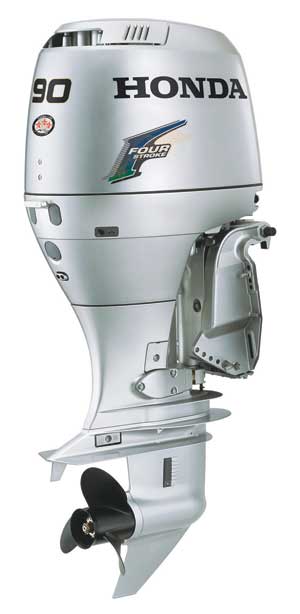The Outboard Expert: Curing the Fishing Line Blues
Simple steps to untangling a common propshaft nightmare.
August 25, 2007

A greasy snag of fishing line lodged against the prop shaft seal could damage the seal and lead to gearcase failure.
Nothing will bring an outboard to a grinding halt faster than a length of fishing line. Gathered up by the propeller, a stray length of line floating in the water can work its way into the gap between the prop hub and the gearcase, where it is next pinched behind the thrust washer. Reeled in by the spinning propshaft, the line gets packed between the washer and the propshaft seal. Jammed against the seal by hundreds of pounds of thrust, the line grows hot with friction and begins to eat its way into the soft rubber of the shaft seal. If enough line is present and it goes undetected, the stray string eventually compromises first the outer and then the inner seal, allowing the gearcase lube to seep out and water to leak into the case. Under load and lacking the cushion provided by a layer of lubricant, the gears begin to gall as metal contacts metal. The bearings are toast. And you are left facing a considerable bill for a rebuilt gearcase or a replacement.
Couldn't happen to you? I mean, what are the odds?
"I find fishing line on a prop shaft at least once a week," said Dan Jansen, a technician at Mr. Marine, a busy Mercury dealer and rigging shop on Lake Winnebago in Fond du Lac, Wisconsin. "And sometimes it's a real bird's nest, hundreds of feet of line, because there are still anglers out there who think it's OK to strip their reel by letting the line trail out behind the boat while they run across the lake. They leave a booby trap in the water."
And if you are unlucky enough to run across that line, and it fouls in your prop, trouble could be brewing—another reason to pull your propeller and inspect the prop shaft area on a regular basis (see last week's column). If a really long length of line gets behind the thrust washer, the seal could be ruined pretty quickly. But you might be able to get a smaller piece off the shaft before it can work its way through the seal. In some cases, the tangle of line will be obvious as soon as you pull off the prop. But a smaller piece of line can get pressed into the grease that accumulates around the area where the shaft passes through the seal. Try scratching this area with a finger nail, or very carefully with a small, hooked tool, to find line imbedded in the grease. If you are pulling line out of the seal, or if the line appears to be melted, you probably have trouble.
Jansen pointed out that all late-model Mercury outboards, and most other brands, have a sharp steel edge around the lip of the outer seal that is supposed to cut fishing line and prevent catastrophe.
"But it's been my experience that the line-cutter often doesn't help," said Jansen, "especially if the fishing line is some of the newer braided line. That stuff is really strong and presents edges that make it cut right through the seal like a serrated knife."
If you find line on the propshaft, Jansen suggests next checking the lube. Trim the motor down and remove the drain screw from the bottom of the gearcase (see your owner's manual for its location). To drain good lube from the case, you'd have to also open the vent screw, "But if there's water in the case and the motor has been sitting for a little while, it will be at the bottom and will run right out," said Jansen. In which case you need to get the seals replaced, and have the gears and bearing inspected in the process. You can also have a dealer pressure-test the gearcase to check the integrity of the seals.
The Spin Method

Sliding the line snag up the shaft. Next step is to open the gearcase drain and check for water in the lube.
Here's a shade-tree way to give your gearcase a quick check. With the boat on the trailer and outboard in neutral, give the prop a spin. The high-viscosity lube in the outboard gearcase should arrest the motion of the prop quickly. If the prop spins free, however, the lube could be diluted with water. I know an aspiring bass angler who has made it a habit to spin his boat's prop every time he walks past the back end of the boat, and he knows just how it should spin when the lube is OK. He claims to have discovered water in the case twice using this method.
Editor's Note: Charles Plueddeman is the editor at large for Boating, the nation's largest boating magazine.












